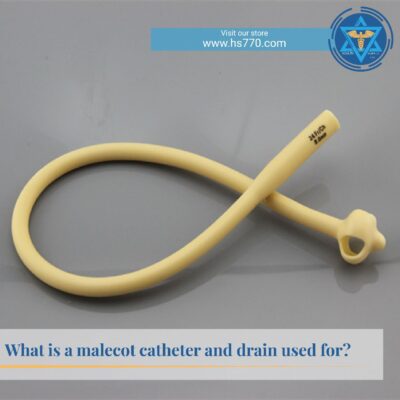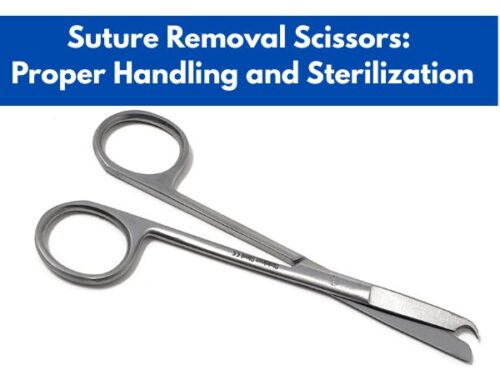What is a Malecot Catheter and Drain Used for?

A Malecot catheter, also known as 4-winged perforated mushroom catheter or flower tip catheter, is a device temporarily placed in the renal pelvic area with an aim to allow the drainage of percutaneous fluid, a process called nephrostomy. It is commonly recommended to the patients after they undergo a renal procedure such as kidney or urinary bladder surgery.
Additionally, Malecot drain catheters have various advantages over others due to:
- Better retention (up to 4 weeks or more if needed)
- Lesser risk of accidental falling out of the bladder
- Enhanced drainage particularly of the viscous fluids
- More patient compliance as fewer replacements are needed
- Ease of cleaning (with water and detergent followed by boiling, dry heating, chemical disinfection or autoclaving)
- Available in single-use as well as reusable forms
- Self-retaining property
- Malecot catheter sizes provide a wide range of options for selection according to the need
Where is Malecot Catheter placed?
Malecot catheters are placed into the urinary bladder to provide assistance in urine flow. To place a Malecot drain catheter into the body, the stylet is put inside the catheter and its position is secured with the luer lock. This straightens up the flower wings. Further, a guide wire is attached to the Malecot catheter to advance it into the collecting system where it starts drainage. Its dilated winged ends results in its better retention into the body cavities thus enhancing functionality.
Malecot Catheter Uses
There are several conditions in which a Malecot drainage catheter is useful such as:
- It is used when a urine examination is to be done.
- It also finds its utility in procedures such as bladder irrigation.
- It can be employed to deliver drugs to the bladder.
- It can be helpful in measuring the residual volume of the urine.
- It can be used to evaluate urine retention issues in the patients with urinary incontinency.
- It is also used in patients who cannot control their urinary flow such as after a prostate or genital surgery or in case of multiple sclerosis, spinal injuries and even dementia.
What is a Foley vs catheter?
Catheters are the soft thin tubes inserted into or placed onto the body cavities to allow the drainage of fluids in conditions when the patient is unable to do so without assistance. They can be placed into the bladder for longer time (indwelling catheters) or can be placed and immediately removed after urine drainage (intermittent catheters). Another type of catheters is condom catheters used in male patients as a covering over the penis. All three of these collect the urine and transfer it to a drainage bag connected to them via a plastic tube. A Foley catheter as well as a Malecot drain catheter is a type of indwelling catheters.
A Foley catheter is a soft narrow tube with multiple ends used to drain urine in case of a urinary obstruction or a medical condition which hinders its passage out of the body such as enlargement or scarring of prostate gland. It is also helpful in cases such as weakness of bladder muscles or damaged bladder nerves, conditions which result in an inability to fully empty it.
They are made up of various materials such as latex, plastic, rubber, silicone or teflon and are available in different sizes in which the size of balloon varies particularly. It is an indwelling self-retaining catheter which is held in place once the balloon is inflated.
Foley catheters have a tube shaped structure with an inflatable balloon at the end which is to be inserted into the urinary bladder while the other end possesses two or three lumen openings. One of these is connected to the balloon and is used to inflate it once the catheter is set into its place. The other one is for the urine drainage.
In 2-way or double-lumen Foley catheters, one lumen is used to inflate the balloon by inserting normal saline or water using a syringe while the other end is connected to the drainage bag. However, in 3-way Foley catheter, in addition to these two, another lumen is present which can be used to irrigate the urinary bladder by administering a solution via a syringe.
What is a self-retaining catheter?
A catheter, when placed into the urinary system, should ideally stay in place for a specified period of time. It becomes a requirement while dealing with patients who have certain medical conditions restricting the normal flow of urine outside the body. A catheter, in this case, will help pass the urine directly from bladder to a connected drainage bag. This way, despite of the patient’s inability to empty the bladder naturally, this small tube does the job.
Foley or Malecot drain catheters have a mechanism to stay in place for longer periods of time due to their unique inflatable designs. They are in the form of soft thin tubes which are advantageous for easy insertion. Once inside the body, they inflate as in case of Foley catheters or expand like the Malecot catheters do. This inflated or expanded end cannot come out of the orifices thus preventing the accidental falling out of the catheters from the urinary bladder.
The drainage bags connected to these catheters via a connecting tube can be emptied or replaced once full but there remains no need to take out the catheter multiple times. It can in fact be left into the urinary bladder for extended periods such as 4 weeks or more if the physician recommends.
What are the 4 types of catheters?
Catheters are used for different purposes as they provide assistance in the treatment of many diseases. These are also used in many surgeries. Mainly, catheters have 4 types which are used for different purposes. Here in this article we are going to have a detailed view of these four types of catheters.
Urinary Catheters
Urinating is a basic function of the human body which helps to cleanse wastes and fluids present in the body. If for any reason, a person cannot urinate on his own, then these urinary catheters are used to release urine from the body. These catheters are also used for removing urine from the body before different surgeries. Urinary catheters also have different types including External, Foley, Intermittent, Suprapubic, and Condom catheters.
The type of catheter to use and the duration for which you should use it depends upon your health status and should be recommended by your doctor. These catheters are used in cases of bladder or kidney stones. These are also used for blood clots in the urine, severe enlargement of the prostate gland, dementia, spinal cord injury, and bladder’s nerve injury. They also find applications in different surgeries including surgery on the prostate gland and genital area such as hysterectomy.
Intravenous Catheters
Also known as an IV, these catheters are used to give medications straight into the bloodstream. It has two types:
a. Peripheral venous catheter
It is used for short term and is connected to a vein of the hand, foot, or forearm. It is used to give blood transfusions, chemotherapy, intravenous fluids, and other drugs.
b. Central venous catheter
This type of catheters are used for long term and are connected to the large blood veins of the heart. This type of catheter goes into your arm, neck, leg, or the top of the chest. These are able to stay in the body for months and even years. The reasons for which central venous catheters are used include:
- The need of intravenous medicine for a long time
- Instant need of blood or medicine
- The need to measure blood pressure in one of the large veins
- The need to take blood samples on a regular basis probably several times a day
- They need to give nutrients directly into the blood because the patient cannot take meals normally
- The need to clean the waste material from your blood in the case of dialysis
Diagnostic Catheters
These catheters are used to investigate and diagnose cardiovascular diseases in the patients. The most common reasons to use these catheters include:
- Assessment of the presence and severity of coronary artery diseases
- To check heart muscle dysfunction
- To treat heart valve problems
- To treat congenital heart disease
- To assess abnormal cardiac output
- To assess elevated pressures in the heart’s chambers
- To assess heart muscle inflammation
These catheters help to get more precise information and consequently help in better and focused treatment of the problem. These are also helpful in measuring blood flow and taking samples.
Balloon Catheters
These catheters are helpful to enlarge a narrow passage within the body. This catheter has an inflatable balloon at its tip which helps in this function. After positioning this catheter, it is inflated to help in the treatment required and then it is removed after deflating it again. These are extremely helpful in Angioplasty as they help increase the blood flow to the heart by widening the opening of the blocked artery. Before deflating and removing the balloon catheter, a stent is usually placed which keeps the artery open even after the removal of the catheter. Balloon catheters are also used in the treatment of Ureteropelvic junction (UPJ) obstructions.
Which catheter is best for long-term use?
The choice of the best catheter depends upon the reason it is being used and the severity of the problem. It also depends on different factors such as the materials used in the production of these catheters, coatings, sizes, and designs. These factors are explained below.
Catheter materials
Catheters are made using several different materials. The most common ones are:
Both of these have their own advantages and disadvantages and the selection of the best catheter varies for every patient. Latex catheters provide comfort to the patient as it is a very soft material whereas silicone are tissue friendly and cause less irritation than the Latex catheters However, the International Continence Society (ICS) states that silicon or hydrogel-coated catheters are best for long term use as these minimize frictions during insertion and removal.
Also, it should be considered highly significant that different patients need different catheters as what works for one patient might not work well for the other. For example, red rubber catheters are used by many patients because of the softness and flexibility they provide but for a patient having a latex allergy it wouldn’t work well as the main component used in the manufacturing of these catheters is latex.
Catheter coatings
Coating on the catheters serve many different purposes including providing comfort, protection against infections and protecting the patient against core latex material. Catheters are coated using silicon, Teflon or hydrophilic coatings. However, catheters having hydrophilic coatings are biocompatible and cause less friction providing better comfort for the patient.
Catheter size
The size of the catheter used is highly significant as it can help in the treatment of the problem. A catheter with a large diameter can result in tissue damage whereas a catheter with a too small diameter can increase the risk of catheter blockage. For example, the most common sizes of urinary catheter for adults are 12 Fr and 14 Fr.
Catheter design
The design of a catheter depends upon several factors which are taken into consideration by the designers to design the products according to the performance requirements. The functional requirements of the application helps the designers to identify these requirements clearly. These performance requirements include flexibility, kink resistance, column or push strength, lubricity, and torque transfer characteristics.


















